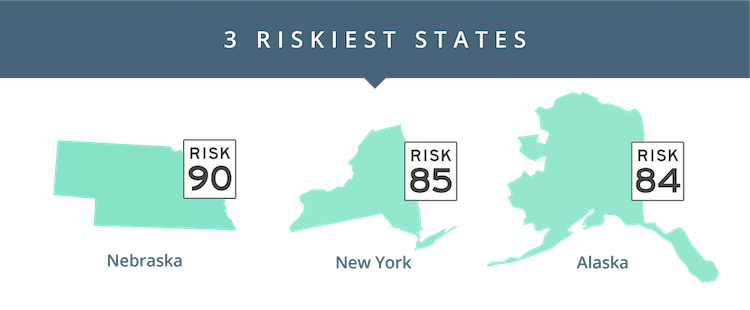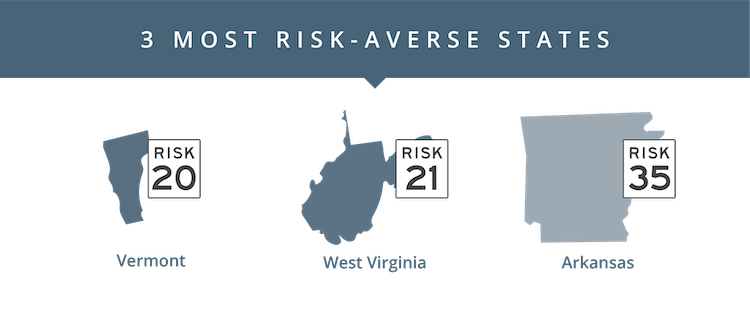Since 2013, advisors have been using the Risk Number® to quantify risk and empower fearless investing for their clients. When we decided to look deeper into Risk Number data, we had some questions about what we’d find: what kind of patterns would emerge city by city, or state by state? Would there be other differences we couldn’t quantify? What if we’ve done all this scientific research and risk really is just the same old semantics? [spoiler: it’s not]

Here’s what we found:

Nebraska
- Nebraska has a fiercely independent streak that runs through its history. In the middle of the Great Plains, the state was first settled by pioneers looking to make a name out west as part of the Homestead Act. It also has the only unicameral legislature in the country—no easy feat in this political environment.
New York
- New York has a population of 19 million—over 8 million in New York City alone. With an average income of over $58K a year, New Yorkers have a little more flexibility to take risks. And it’s only fitting that the home of Wall Street would be among the riskiest.
Alaska
- As of 2018, Alaska, Nebraska, and New York have some of the lowest populations of residents aged 65 or older. In fact, Alaska ranks 50th with only 9.49%. When you see that Alaska contains about 98% of the U.S. brown bear population, a little more investment risk is small potatoes for the Last Frontier.

Arkansas median household income: $41,995
Vermont median household income: $56,990
West Virginia median household income: $42,019
Vermont
- Vermont ranks 8th in Education and 16th in Fiscal Stability. Its status as one of the least risky states could be due to the fact that 26% of Vermont’s residents are 55 or older. Vermont’s reputation as a progressive state notwithstanding, its residents prefer to play it safe with their money.
West Virginia
- West Virginia, like Arkansas, has a large mining community that didn’t see the growth other sectors experienced after the recession. It ranks 45th in Education, 49th in Economy, and is 50th in Employment. We believe risk is directly correlated to an individual’s current position, and unless changes occur, West Virginians will continue to be cautious.
Arkansas
- Fun fact: Arkansas has the only active diamond mine in the US. The Natural State is also home to one of the biggest companies in the world, Walmart. However, Arkansas ranks 42nd in Education, 40th in Economy, and 41st in Opportunity. Arkansas investors just don’t want to risk it.
We collected this data over seven years and are still discovering just how many outside factors contribute to an investor’s Risk Number. Risk tolerance is such a multivariable dynamic that placing investors into subjective buckets based on their age simply doesn’t cut it.
We believe investors are individuals, and our research has confirmed that belief time and time again.
So, how risky is your state?
Alabama 
- 32nd Riskiest
- Ranked 46th Overall by US News
- Has no official nickname
Arizona 
- 39th Riskiest
- Ranked 12th in Infrastructure and 39th in Quality of Life
- The copper dome of Arizona’s capitol building is made with the equivalent of 4,800,000 pennies
California 
- 19th Riskiest
- Ranked 4th in Economy and 50th in Quality of Life
- Nitrogen was founded in Auburn, California
Colorado 
- 12th Riskiest
- Ranked 1st in Economy and 5th in Health Care Quality
- Marijuana is a $1.56 billion-dollar industry in Colorado as of 2018
Connecticut 
- 42nd Riskiest
- Ranked 4th in Health Care and 41st in Infrastructure
- Connecticut imposed the first speed limit for a motor vehicle in 1901, a blistering 12 mph
Delaware 
- 22nd Riskiest
- Ranked 7th in Opportunity and 10th in Economy
- Delaware is only 100 miles long and 35 miles wide
Florida 
- 47th Riskiest
- Ranked 15th Overall by US News
- Rumor has it: Floridians are never more than 60 miles away from salt water
Georgia 
- 9th Riskiest
- Ranked 10th in Growth and 45th in Health Care Access
- Bank of America Plaza Atlanta is the tallest building in the southeast and home to Nitrogen’s East Coast headquarters
Hawaii 
- 38th Riskiest
- Ranked 1st in Health Care and 23rd in Economy
- From 1847 to 1898, Hawaii had it own currency known as the dala
Idaho 
- 34th Riskiest
- Ranked 12th Overall by US News
- Idaho’s most famous crop (potatoes) aren’t native to the area—they’re from New Hampshire
Illinois 
- 31st Riskiest
- Ranked 50th in Fiscal Stability and 13th in Energy
- Generates more nuclear power than any other state
Indiana 
- 18th Riskiest
- Ranked 11th in Opportunity and 48th in Quality of Life
- The town of Santa Claus, Indiana receives over 400,000 letters from children during the holidays
Iowa 
- 16th Riskiest
- Ranked the #1 State Overall by US News
- The best thing since sliced bread, which was actually invented in Iowa in 1912
Kansas 
- 33rd Riskiest
- Ranked 42nd in Economy
- Is there anything more perfect than a state at the country’s geographic center having a 50 Risk Number?
Kentucky 
- 29th Riskiest
- Ranked 9th in Crime & Corrections and 45th in Economy
- Bourbon barrels outnumber people in Kentucky
Louisiana 
- 30th Riskiest
- Ranked 50th in Opportunity and 49th in Education
- Louisiana has over 2 million wild alligators
Maine 
- 24th Riskiest
- Ranked 1st in Crime & Corrections and 37th in Economy
- No one knows how Maine got its name
Maryland 
- 6th Riskiest
- Ranked 2nd in Opportunity and 11th in Education
- The official state sport of Maryland is Jousting
Massachusetts 
- 25th Riskiest
- Ranked 1st in Education and 8th Overall by US News
- Site of the Fearless Investing Summit in 2019
Michigan 
- 17th Riskiest
- Ranked 4th in Affordability and 36th in Education
- Detroit has its own currency known as the “Cheers”
Minnesota 
- 40th Riskiest
- Ranked 2nd Overall by US News
- Home to the biggest mall in the country, the Mall of America
Mississippi 
- 44th Riskiest
- Ranked 49th Overall by US News
- The Old Spanish Fort Museum in Pascagoula, MS has the world’s largest shrimp on display
Missouri 
- 8th Riskiest
- Ranked 10th in Internet Access and 15th in Quality of Life
- “Show Me” your neighbors—Missouri is bordered by eight different states
Montana 
- 45th Riskiest
- Ranked 26th in Economy and 7th in Energy
- Montana’s Glacier National Park is the only place in the US where water flows to the Pacific, Atlantic, and Hudson Bay
Nevada 
- 36th Riskiest
- Ranked 5th in Infrastructure and 44th in Education
- Even though California is called the Golden State, most gold in the U.S. actual comes from Nevada
New Hampshire 
- 35th Riskiest
- Ranked 5th Overall by US News
- Live Free or Die: New Hampshire was the first colony to declare independence from England
New Jersey 
- 46th Riskiest
- Ranked 2nd in Education and 49th in Fiscal Stability
- The famous duel between Aaron Burr and Alexander Hamilton took place in Weehawken, New Jersey
New Mexico 
- 48th Riskiest
- Ranked 8th in Quality of Life and 50th in Education
- The first atom bomb was tested in Alamogordo, New Mexico in 1945
North Carolina 
- 27th Riskiest
- Ranked 6th in Fiscal Stability
North Dakota 
- 4th Riskiest
- Ranked 1st in Quality of Life and 2nd in Fiscal Stability
- Being the #1 producer of honey makes life pretty sweet
Ohio 
- 20th Riskiest
- Ranked 21st in Public Safety and 32nd in Economy
- 25 NASA astronauts have hailed from Ohio
Oklahoma 
- 15th Riskiest
- Ranked 9th in Social Environment and 48th in Health Care
- ‘Tis the season—Oklahoma’s state flower is mistletoe
Oregon 
- 11th Riskiest
- Ranked 3rd in Infrastructure and 45th in Affordability
- Marijuana sales in Oregon were over $777 Million in 2018
Pennsylvania 
- 43rd Riskiest
- Ranked 16th in Opportunity and 44th in Quality of Life
- The Foxburg Country Club in Foxburg, PA is the oldest golf course in the US
Rhode Island 
- 23rd Riskiest
- Ranked 8th in Public Safety and 8th in Health Care
- Rhode Island is only 48 miles long and 37 miles wide
South Carolina 
- 21st Riskiest
- Ranked 15th in Economy and 48th in Education
- On April 12, 1861, the Civil War began at Fort Sumter in South Carolina
South Dakota 
- 28th Riskiest
- Ranked 5th in Quality of Life
- Home to Mount Rushmore
Tennessee 
- 7th Riskiest
- Ranked 5th in Fiscal Stability and 46th in Public Safety
- Major industries include mining, farming, music, and uranium products
Texas 
- 13th Riskiest
- Ranked 8th in Economy and 26th in Energy
- The Texas oil boom of the early 20th century is known as the Gusher Age
Utah 
- 26th Riskiest
- Ranked 1st in Fiscal Stability, 2nd in Economy, and 3rd in Education
- Utah was ranked the most charitable state
Virginia 
- 10th Riskiest
- Ranked 7th in Pubic Safety and 41st in Growth
- Virginia is the birthplace of the most US Presidents (8)
Washington 
- 37th Riskiest
- Ranked 2nd in Health Care and 3rd in Economy
- There are over 3,000 glaciers in Washington
Washington DC 
- 5th Riskiest
- Washington DC median household income: $82,372
- DC loves its wine—it drinks more rosé per capita than anywhere else in the US
Wisconsin 
- 41st Riskiest
- Ranked 3rd in Quality of Life and 8th in Opportunity
- Wisconsin produces 25% of the nation’s cheese
Wyoming 
- 14th Riskiest
- Ranked 9th in Fiscal Stability and 49th in Growth
- According to the National Park Service, more people are injured by bison than grizzly bears in Yellowstone National Park
